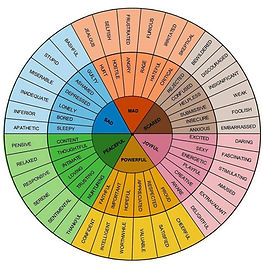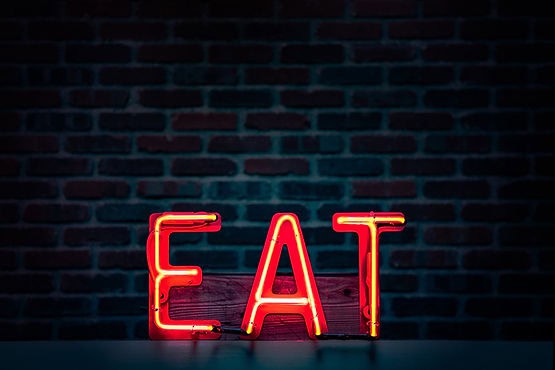You Won’t Break Free From Emotional Eating Without This (Your Non-Negotiable Tool for Healing Your Relationship with Food)
Are you tired of the endless cycle of emotional eating, where your food choices are driven by stress, boredom, or other emotions? Your relationship with food—your body and yourself too—is no doubt impacted by this behavior and how you approach your emotions. Today we’ll explore the powerful practice you cannot neglect if you want to break free from emotional eating.
Can you guess what it is?

Emotional eating affects many people, often leading to weight gain (no! this is actually not a bad thing but with all the guilt-tripping by diet culture happening, it can definitely feel like the worst thing!), guilt, and a strain on mental and physical well-being. As much as you likely beat yourself up, criticize your lack of control or willpower, and vow that “this time” will be the last, you need to know that this behavior is far from self-sabotage.
All of us are doing something with our emotions.
If you use emotional eating to avoid them, suppress them, or ignore them, congratulations! You have adopted a behavior to take care of yourself!
Don’t you think that if you had another well-practiced, healthier habit with which to care for yourself, you would use it?! You’re not sabotaging—you’re protecting!
It’s through this lens that we must begin viewing emotional eating, if we plan to change it! This expansion of our view involves meeting ourselves with kindness and understanding. When we view our behavior in this way—as a method of taking care of ourselves when we don’t have any other option or skill—we are able to look at ourselves with less disdain and shame!
Yep! You guessed it! This non-negotiable tool is SELF-COMPASSION!
Self-compassion allows us the space to regard ourselves with more openness and curiosity! It invites us to recognize our emotions, understand our triggers, and develop healthier coping skills beyond turning to food.
As we forge ahead, I’ll be sharing helpful strategies for practicing self-compassion, including somatic (body-oriented) strategies, mindfulness techniques, journaling exercises, and seeking support from loved ones or professionals.
Breaking free from emotional eating isn’t solved in a day. Yours won’t be solved by the end of this article! But with self-compassion as a guide, we can make significant progress towards a healthier and more balanced relationship with ourselves that can shift our relationship with food… over time, with consistency, and lots of patience.
Understanding Emotional Eating to Break Free from Emotional Eating
Emotional eating is a common phenomenon where individuals use food to cope with emotions that they don’t have other skills with which to approach them.
Many reasons exist for not being able to meet emotions, including growing up in an environment in which particular emotions were punished; witnessing specific emotions demonstrated by others that led to harmful or dangerous situations; traumatic experiences; etc.
Emotional eating often involves consuming food in response to feelings of stress, sadness, loneliness, or even happiness. Yep, you may resonate with having grown up in a household where jubilance, glee, or loud and boisterous energy was reprimanded.
While occasional emotional eating is normal (i.e., at celebrations, funeral, get-togethers), frequent reliance on food to manage emotions can lead to negative consequences for our health.
What we resist, persists. While you may experience a sense of reprieve from the emotion you were experiencing when you moved to food, that emotion will be on the backside of the eating, right? To heal, we need to feel.

What I hear from so many of my clients, and what I experienced myself for many years, was a cycle like this:
emotional eating
⬇
guilt
⬇
restriction
Repeat.
It’s possible that the emotional eating behavior you’re engaging in is more associated with dieting or inadequate food intake than it is solely to cope with an uncomfortable emotion.
If that’s the case, and you are someone who is restricting your food intake, for whatever reasons, the restriction needs to stop in order for you to develop the requisite skills to be with the emotions you experience and not have those emotions compounded by significant hunger.
Unmet hunger needs will create a sympathetic nervous system response that feels like either fight or flight energy (high anxiety, nervous, activated and buzzy) or shutdown (withdrawal, very low and heavy energy).
This being said, what often occurs, is someone learns to soothe uncomfortable emotions with food, and due to diet culture’s stigma associated with body changes (i.e., weight gain), they will start dieting to mitigate those changes.
Developing awareness around emotional eating behaviors and any accompanying behaviors, like restriction, following food rules, attempting to manipulate or change your body, etc., is the first step towards healing.
The Impact of Emotional Eating on Physical and Mental Health
Emotional eating can have significant implications for both physical and mental well-being. From a physical standpoint, frequent consumption of high-calorie, low-nutrient foods as a response to emotions can contribute to weight gain, nutritional deficiencies, and overall poor health outcomes. While there is no scientifically valid reason to fear weight gain, because we live in the culture we do, it often leads to behaviors (i.e., yo-yo dieting, restriction, cutting out food groups) that can exacerbate the problem.
Additionally, the cycle of emotional eating may disrupt hunger cues, leading to irregular eating patterns which can compromise adequate food intake overall, sleep, as well as general blood sugar and energy levels. If you’re active and love training, your workouts, recovery, and adaptation can be negatively affected.
On the mental health front, emotional eating can exacerbate existing emotional struggles and create a feedback loop of negative emotions. Feelings of guilt, shame, and self-criticism often accompany episodes of emotional eating, further perpetuating the cycle of unhealthy coping mechanisms. Over time, this can take a toll on self-esteem, mood regulation, and overall psychological well-being.
It’s essential to recognize that emotional eating is a symptom of underlying emotional needs that are not being adequately met. Addressing these needs with compassion and understanding is key to breaking free from the destructive patterns of emotional eating and cultivating a healthier relationship with food.
The Role of Self-Compassion in Overcoming Emotional Eating
Self-compassion plays a pivotal role in breaking free from emotional eating and fostering a healthier relationship with food. Rather than approaching emotional eating with self-criticism or judgment, self-compassion invites individuals to treat themselves with kindness, understanding, and acceptance in moments of struggle.
I’m guessing that while you understand the concept, the application feels next to impossible! You’re not alone if you feel this way.
Most of us can describe what it’s like to offer compassion to a friend or loved one when they’re struggling, experiencing difficulty, when they feel inadequate, or when they’re really going through a rough time of it, right?
But most people I work with will tell me that it’s much more difficult to offer themselves what they do the people who are important to them. They know how to do it- they do it all the time. But to do the U-turn required to offer the same gentleness feels… awkward? Foreign? Silly even. It’s interesting, right?
We’d be remiss if we didn’t acknowledge the cultural influences here. I think of the old adage of “pull yourself up by your bootstraps.” In other words, there’s no room for emotion. Get on with it.
Or how many of us have been told to “just get over it”? And I’ve already mentioned the different ways in which many of us grew up with caregivers who couldn’t acknowledge their own pain, difficulty, or emotion, and as such, left no space for us to express our own.
We were punished for feeling, and so we learned that feeling or experiencing difficulty is not tolerated. Is it any wonder that we have a difficult time offering it to ourselves?
What also happens when we’re offered compassion from someone else is we feel vulnerable.
Naked.
Exposed.
We may be thinking, “It’s really okay to feel what I feel?”
To struggle?
To be fallible?
To be messy?
To not have everything figured out?
To feel like I’m a leaf being tossed around by the wind?
It’s helpful to reflect upon this experience through a parts lens.
Remember that different parts of us, at different times, feel incredibly vulnerable. They’re holding onto burdens of shame, a sense of unworthiness or not enoughness.

When these emotions arise, we can meet the part or parts of us that are experiencing them with lots of presence. That’s all this is.
I’ve found that the parts work was so important in my being able to integrate self-compassion into my own healing.
When we give ourselves compassion, we’re essentially giving the parts of us that are showing up with the shame, intense feelings, or pain, what they need and didn’t receive when they needed it in the past!
Kristin Neff, the leading researcher of self-compassion describes what happens when we’re met with compassion:
Some people find that when they practice self-compassion, their pain actually increases at first. We call this phenomena backdraft, a firefighting term that describes what happens when a door in a burning house is opened – oxygen goes in and flames rush out.
A similar process can occur when we open the door of our hearts – love goes in and old pain comes out. There are a couple sayings that describe this process: “When we give ourselves unconditional love, we discover the conditions under which we were unloved” or “Love reveals everything unlike itself.”
Fortunately, we can meet old pain with the resources of mindfulness and self-compassion and the heart will naturally begin to heal. Still, it means we have to allow ourselves to be slow learners when it comes to practicing self-compassion.
And if we ever feel overwhelmed by difficult emotions, the most self-compassionate response may be to pull back temporarily – focus on the breath, the sensation of the soles of our feet on the ground, or engage in ordinary, behavioral acts of self-care such as having a cup of tea or petting the cat.
By doing so we reinforce the habit of self-compassion – giving ourselves what we need in the moment – planting seeds that will eventually blossom and grow.
3 Elements of Self-Compassion
The first element of self-compassion is kindness vs judgment.
Kindness vs judgment: being warm and understanding vs self-flagellating and leveling ourselves with criticism when we feel inadequate, when we’ve made a mistake, when we feel less than.
- We approach ourselves the way a mentor, coach, or good friend would
- Puts us in a position to respond with more perspective, openness, and curiosity and make the necessary changes
- This sounds like, “this is a moment of difficulty” or “this doesn’t feel good” or “this hurts” or “I don’t like how this feels” or “I’m struggling right now.”
- When we’re kind, it makes space for acknowledgement. When we judge, we create a situation whereby we layer more difficult feelings on top of the ones we’re already experiencing. In Buddhist philosophy they call this added layer of difficulty “the second arrow.” The first arrow is the initial pain or suffering. The second arrow is our resistance or judgment of that pain. The act of resisting something adds to the difficulty of it.
The second element of self-compassion is common humanity vs isolation.
Common humanity vs isolation: often when we’ve made a mistake or feel inadequate we get this sense that we’re the only one experiencing the feelings that we are in that moment.
We become very myopic in our vision and perspective. We put ourselves in the center of the arena– all eyes are on us. Like we’re waiting for everyone to throw the rotten fruit at us.
But isolation is not the truth of feeling flawed. It’s a common human experience. We all suffer. We all experience difficulty. We all make mistakes. We all experience regret. We ALL EXPERIENCE HARD EMOTIONS! No one will get out of this life without feeling hard emotions.
When we experience difficult emotions, it can be a cue to remember that the vulnerability we’re experiencing is connecting vs separating. It lets us know that we’re part of the HUMAN RACE. We’re not unique in this way! To me, this is validating and helpful!
Now, while we may feel like isolating and being by ourselves when we’re experiencing something difficult, I believe this is often because of the criticism and judgment we’re leveling at ourselves.
Our biological impetus is to connect. To be within community. To be known and loved. Indeed, connection is one of our basic psychological needs. So if we can practice kindness vs criticism, we are well on the path to connecting vs isolating, and thus healing.
Shame lives in the dark. The antidote to shame is vulnerability with other humans who will identify with us!
The 3rd element of self-compassion is mindfulness vs overidentification.
Mindfulness vs overidentification: Mindfulness means “non-judgemental awareness.”
When we’re mindful, we have just enough distance from the suffering we’re feeling to recognize that it’s not the WHOLE of our experience.
We have a present that includes a lot of other things– people, emotions, and experiences, and this is one drop in the vast ocean that is our individual life.
- When we can use mindfulness in this way, it gives us perspective so we don’t get swept away or swallowed up by negative reactivity
- On the same token, mindfulness allows us to experience MORE THAN ONE emotion at the same time. This is what it means to hold the dialectic – to experience seemingly opposing concepts at once. One of my clients shared with me that the single most profound thing she learned through our work together was that she was allowed to feel multiple feelings at the same time. That this was okay!
In fact, it was a beautiful skill that would allow her perspective and to move through the world knowing that different parts of her would feel different things. Again though, in a culture that promotes black and white, uses terms like “wishy washy” to describe someone who can’t make up their mind (and of course, this operates on continuum, but you get my point), and almost punished people who CHANGE their minds, it makes sense that we would feel like we need to land firmly in one place. How realistic is that? Every choice we make has consequences, positive or negative or in between.
What gets in the way of self-compassion?
To be frank, criticism and judgment, isolation, and overidentification.
So if we know these things won’t help us with self-compassion, we can be aware of when they are present, right?
If we hear criticism and judgment, we can acknowledge it.
“Okay, there is criticism here. I can feel myself building up rigidity…. If I soften a bit, what might it sound like to be kind?”
“If I did the opposite of isolate, even though my impetus is to hide, who might I connect with to share this difficulty?”
And when you notice you’re catastrophizing (making something bigger than it is or overidentifying with the ick of it to the point that you can’t see the forest for the trees), you might ask yourself:
“What else is present here? How was I feeling 10 minutes ago?”
So you can widen the lens.
The other thing that gets in the way of self-compassion is not having boundaries.
I think that if we have far too porous boundaries, whereby we aren’t clear on what we need or stand for, or how we prefer to be treated, we will likely overfunction in other people’s lives and create a situation in which we aren’t respected.
It’s been said that we teach people how to love us. We teach people about us. People can’t know us, really, unless we have boundaries. What boundaries do is they help people understand us and what is important to us!
Perfectionism is also a barrier to self-compassion.
This looks like believing that you must get things absolutely right or you’re a failure…
or believing that rest and replenishment is lazy.
A lot of this involves uncovering your limiting beliefs and understanding where they come from. Many, as we’ve talked about might come from the dieting mindset or diet culture, and many likely stem your family of origin.
The Emotional Eating Sequence of Events
Now, as you’re well aware, often emotional eating occurs because we push away emotions. And as we resist them, we use food to focus us elsewhere.
My clients have shared with me that they believe the pattern of behavior looks like this when we first start digging in together:
We feel uncomfortable feelings
⬇
We eat
But in reality, it happens like this:
We feel uncomfortable feelings
⬇
We are unable to tolerate them
⬇
We eat
⬇
We self-criticise
⬇
We can’t tolerate the emotions
⬇
We resolve to lose weight or we eat some more to combat the additional negative feelings from the criticism
Of course, important here is to begin learning how to tolerate feelings that don’t feel good! And this means developing resources to support yourself!
The second and very important piece of this though is when/if you eat, to replace the self-criticism with self-compassion. This is not me saying there won’t be disappointment or sadness… or whatever other emotion is common for you after you eat due to emotional discomfort!
This is me saying, notice how the self-criticism feels and remember why it’s important for you to do something different and more nourishing here.
Because listen, if you can practice replacing the criticism with self-compassion, it’s highly unlikely that you’ll jump back into a diet and harm yourself further.
Self-compassion aids in your adapting to uncomfortable circumstances and helps you meet difficult goals.
Shame and criticism erodes your confidence and motivation.
So where would you rate yourself in your ability to offer yourself compassion when you’re experiencing difficulty?
When you’re made a mistake?
When you are disappointed with how you acted?
When something has happened that you’re responsible for, and it didn’t go the way you wanted it to?
Scale of 1-10?
10 being you’re not perfect, but most of the time you can be gentle with yourself so you have the space to acknowledge and move forward wisely.
As you can see, with self-compassion, you can begin to untangle the emotional roots of your eating patterns and develop more adaptive ways of coping with difficult emotions. Instead of using food as a band-aid for emotional pain, self-compassion invites you to acknowledge your feelings, validate your experiences, and seek out other healthier ways of resourcing yourself.
Practicing self-compassion involves recognizing that emotional eating is a common response to distress and that individuals are not alone in their struggles. By offering yourself the same care and compassion that one would offer to a friend in need, you can shift your relationship with yourself (and food) towards one that is grounded in self-awareness and self-care.
Cultivating Self-Compassion through Mindfulness Practices
One way that you can bring the element of non-judgment and presence to your emotions is first by practicing doing so with your other sensory experiences. Mindful eating offers a practice that can support this skill.
Mindful eating involves paying attention to the sensory experience of eating, such as the taste, texture, and aroma of food, as well as the physical sensations of hunger and fullness. By approaching meals with a sense of curiosity and non-judgment, you will experience a different tone with food and more importantly, feel what it’s like to pay attention differently.
In addition to mindful eating, mindfulness meditation practices can help individuals build emotional resilience and self-awareness. As a mindfulness meditation instructor, this practice is one I hold in high regard. The feeling of breathing offers us a ready-made anchor for practicing concentration, as well as presence. You might try, for a moment, just to feel what it feels like to breathe. Feel your chest and stomach expand with the inhale. Feel the release and relaxation when you exhale.
When you’re experiencing heightened activation (or hypo – lower than normal energy—) in your body (yes, this is often what is happening before you reach for food), your breath can be a resource for finding more calm and stability.
Extend the exhale to increase calm if activated. Extend the inhale if you want to move into more energy from a low-energy (withdrawn) state.
By incorporating everyday mindfulness practices like these into your daily routines, you can develop a more balanced and nourishing approach with yourself.
Identifying Triggers and Developing Coping Mechanisms
Understanding the triggers that lead to emotional eating is essential for developing effective coping mechanisms and breaking free from this pattern. Triggers for emotional eating can vary widely from person to person and may include stress, boredom, loneliness, anxiety, or even positive emotions such as celebration or reward.
One effective strategy for identifying triggers is keeping a food and mood journal, where you can track your eating patterns alongside your emotional state. By noting when and what you ate, in addition to the emotion you were experiencing when you ate, you can identify patterns and triggers that contribute to emotional eating episodes.
I will say that most of my clients can’t identify their emotions! They also are so disconnected from their bodies, that my suggestion to tune in and notice what’s happening in regards to the sensations they’re experiencing, feels very foreign.
If this is you, again, know you’re not alone! But also know that you can learn how to do this, and it will be key to overcoming this behavior. It will also be valuable for the rest of your life outside of your relationship with food!
Once triggers have been identified, you can then work on developing alternative coping mechanisms that address the underlying emotional needs without resorting to food. I like to call these coping mechanisms, resources. They might be resources you access on your own, or they might be resources that involve other people. They might be resources inside of you! Or they might be resources within your external environment.
For example, this might involve engaging in physical activity, practicing relaxation techniques, seeking social support, or engaging in creative outlets as healthier ways of managing emotions.
In The Confident Coping Without Food program (aka: Food & Body Freedom Experience), we spend a significant portion of our time together learning about the nervous system, how our bodies communicate with us about what they need and are experiencing, and how to meet their needs with different resources!
Summary: Building a Healthier Relationship with Yourself (and Food) through Self-Compassion
Building these healthier relationships starts with cultivating self-compassion and approaching your emotions and eating behaviors with kindness, awareness, and care. Rather than viewing food solely as a source of comfort or punishment, it can be seen as a form of nourishment and self-care that supports your overall well-being.
Self-compassion invites a different process, free of guilt and shame that often accompanies emotional eating. Instead, it fosters self-awareness and self-acceptance. By treating ourselves with compassion in moments of struggle, we can make wiser choices in all areas of our lives that are aligned with our values and intentions.
Practicing self-compassion also involves letting go of unrealistic expectations and perfectionism around eating. It’s a radical shift though when you look at what most of us have internalized about food and our bodies!
Self-compassion is not black and white! Rather than striving for strict dietary rules or punishing exercise routines, a self-compassionate approach encourages listening to their bodies, honoring our hunger and fullness cues, and making food choices that feel nourishing and satisfying on many levels.
Seeking Professional Help for Emotional Eating
If you’re struggling with persistent emotional eating patterns that are impacting your quality of life, seeking professional help is a valuable step towards healing and recovery. Addressing the underlying emotional issues that contribute to emotional eating is important. There is no one-size-fits all approach. The practitioner you choose to work with should be well-versed in disordered eating, take a weight-inclusive approach, and not be prescribing meal plans or dietary restrictions.
Ideally, they will be well-trained in disordered eating and modalities such as cognitive-behavioral therapy (CBT), dialectical behavior therapy (DBT), somatic or embodiment approaches, and mindfulness-based approaches can help you develop healthier coping strategies, enhance emotional regulation skills, and build a more positive relationship with yourself, emotions, and food.
If you’d like to discuss working together so you can learn how to navigate the challenges of emotional eating and cultivate a healthier mindset around food and your emotions, let’s look at the options.
Looking for more support?
- Check out my Food & Body Freedom Experience, a 16-week online coaching program with built-in support, a virtual community, and live weekly coaching calls designed to help you end emotional eating and support a peaceful relationship with food and your body.
- Check out my online, self-paced course, End Emotional Eating & Change Your Relationship with Food, that over 400 students have taken, is top-rated, and jam-packed with resources to support your development of new skills!
- Interested in one-on-one support? Contact me to learn more about my Liberated Life coaching options.
- Click here to subscribe to my newsletter for tools and strategies for living your YOUR healthiest life!
- I also offer a complimentary Facebook group, which specifically targets your relationship with food and body!






